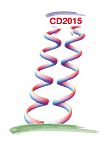Speaker
Jordi Maneu
(University of Barcelona)
Description
Since the discovery in 1952 of the first strange fragment in emulsion chamber experiments, many efforts have been put in extending our knowledge of the nuclear chart, including the SU(3) sector. Worldwide, the study of the interactions among nucleons and hyperons has been a priority in the research plan of many experimental facilities. After more than sixty years of Λ-hypernuclear studies, some attention has moved to more strange systems, with the production of ΛΛ-hypernuclei and more recently, with proposals to study Ξ-hypernuclear spectroscopy.
Our main objective is to calculate the decay rate for the weak decay of ΛΛ-hypernuclei, including all the intermediate baryonic channels allowed by the strong interaction. I will focus on the analysis of the decay induced by the Λ hyperon, i.e., starting with a ΛΛ pair. The weak decay mechanism describing the two-body weak interaction is modelled by the exchange of mesons belonging to the ground state of pseudoscalar and vector octets. The tree-level values for the baryon-baryon-meson coupling constants are derived using SU(3) symmetry for pseudoscalar mesons and the Hidden Local Symmetry for vector mesons. In the computation of the decay rate, the effects of the strong interaction on the initial state are introduced through the solution of a G-matrix equation, with the input of realistic baryon-baryon potentials, while the final hyperon-nucleon wavefunctions are obtained in an analogous way, by solving the corresponding T-matrix equation.
Primary author
Jordi Maneu
(University of Barcelona)
Co-authors
Prof.
Angels Ramos
(University of Barcelona)
Dr
Assumpta Parreno
(University of Barcelona)

